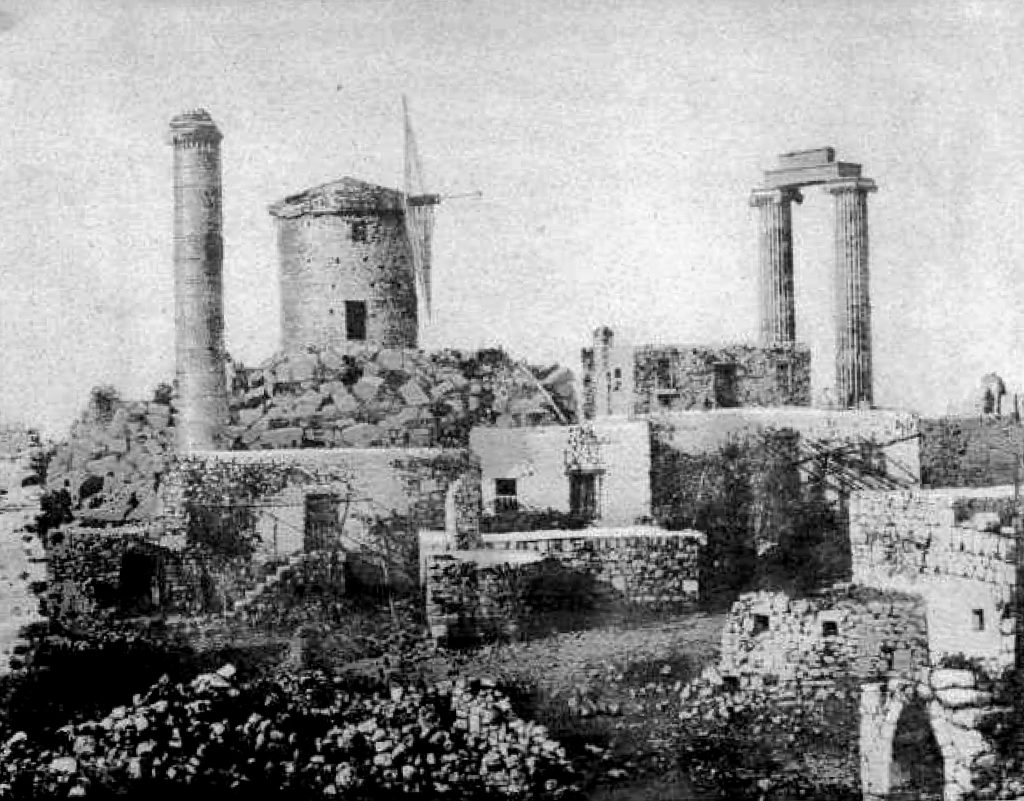As recently reported by Mavi Didim newspaper, writes Glenn Maffia, the mosque sitting beside Didyma’s Temple of Apollo has been closed due to structural fallibility, namely a crack appearing within its masonry. One may well recall this important focus of the village’s religious and communal life was, less than a year and a half afar, subject to an extensive renovation project. Invariably, obvious questions arise.
A walk within history
This modest structure was completed by the inhabitants of the village of Yoran in 1830. There is an inscription stone which can be observed at the top of a flight of stairs located on the north wall (left side when looking at the front entrance).
As the village population during this period were Greek-speaking (the Lingua Franca of the Eastern Roman Empire) and followers of the Christian belief, they constructed a Greek-styled Church, complete with a domed turret upon the roof and that familiar classical style ‘narthex’ to the front of the building.
Christianity was kindly tolerated within the Ottoman Empire, though their taxes were higher than Muslims.
This Church, originally named St. Charalambos, appears to have been constructed above an infinitely older Byzantine place of Christian worship which, given its age, probably fell into a state of disrepair.

A common occurrence is that a Christian sanctuary was built atop a polytheist temple, in this particular case one probably dedicated to Apollo’s twin sister, Artemis. The foundations of which were rediscovered between 2013 – 2014 by the German Archaeological Institute (DAI). Solid foundations, able to support the weight of a substantial structure, withstand seismic pressures and the ever-shifting tectonic plates which blight this geographically active region.
It was a common theme of the Christians to build over polytheist places of worship, namely to eradicate their memory and to usurp an old religion with their own.
A view into the past
The DAI archaeological teams have plotted the ground beneath the current Mosque and my conclusion is this ‘new’ Church was either constructed upon a delicate Roman terrace (my assumption calling it terrace), or the flooring of an earlier, larger, devotional structure.
There is/was a perspex viewing portal beneath a rectangular piece of carpet cut away from the rest of the carpeting within the Mosque. Peering into the portal one can clearly observe this subterranean stonework is, indeed, fragile compared to the Temple of Artemis’ foundations, and it continues entirely under the Church/Mosque and onwards into the courtyard to the front of the structure.

When the DAI excavated some four years back they revealed fragments of Doric-styled stonework within the building’s upper foundations. As we know that Apollo’s and Artemis’ temples were in a style classified as Ionic we can safely contemplate that yet another structure once stood upon this site.
Referencing the map of the area produced by the Dilettanti Society during a field trip in 1811, this, rather rough map, indicated an “Ancient Wall”. The consensus is that this “Ancient Wall” supported a covered area, a Doric-styled Portico or Stoa, to shield people from the intense sun. The remains of this Stoa were subsequently used as part of the foundations of the 1830 Church.
Referencing artistic evidence
The 1811 map also records a church in the same vicinity of the Church/Mosque today. Given the dating, this probably would have been the intermediate Byzantine church. This opinion is supported by Pierre-Anne Dedreux’s drawing from 1820 depicting Didyma and the Temple with the notable absence of the landmark Church.

We require further archaeology to ascertain those finer points. With the Mosque at present being closed, now would be a wonderful opportunity to investigate the 1830 church and the earlier Byzantine place of worship. Though who shall conduct this work; the DAI are not here and are there any native archaeologists suitable or available for this exploration?
A living communal area or an artefact?
Therefore, where do we go from here? We have something of a quandary looming large upon a not-too- distant horizon. Do we preserve and restore the current mosque or should we consider the Roman terrace with favour?
My guess would be, unfortunately for ancient history, the former. I would find it impossible to argue against the mosque, it being a community focal point of Yoran village. Also, it is nigh on inevitable that one ‘history usurps an earlier history’. So, I shall concede this one, though it remains imperative the ‘portal’ should be accessible, and, possibly another one or two in strategic positions within the courtyard, possibly displaying the sturdy foundations of the Temple of Artemis.
Can the Church/Mosque be saved upon those fragile foundations? Can those Roman terrace foundations coexist with that weight upon its delicate fabric? Each time I stand upon the cusp of this hill I can easily imagine in my mind’s eye the view from 2,000 years afar, during the late Roman period.
Standing upon that terrace looking out over the nearing completion of the Temple of Apollo, behind, the elegant Ionic Temple of Artemis with a delightfully shaded Doric Stoa to escape the sun. While glancing to the west one could then have appreciated the finely crafted conclusion to the Sacred Road stretching into the distance of Miletus. We can but dream.
